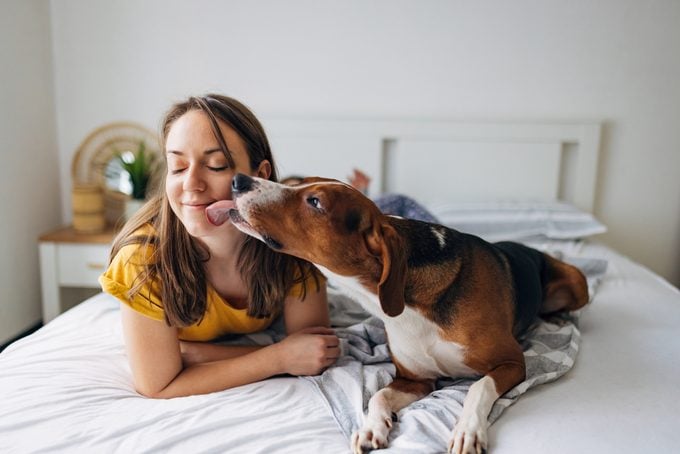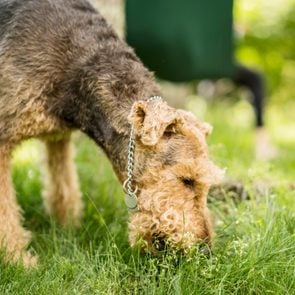Do Dogs Like Kisses? What to Know Before Smooching Your Pup
Updated: Mar. 27, 2023

Our pups are the cutest and sweetest things in our world, so naturally, we want to express our love by giving them oodles of dog cuddles, belly rubs, scratches and smooches. They clearly like being petted, but do dogs like kisses—or even understand what they are?
“Dogs aren’t born into this world knowing what a kiss from a human means,” says Rachel Salant, an animal behavior specialist at Veterinarians.org. And when a dog licks you back, it may be a sign that they love you or something else altogether.
Like with so many things, we tend to forget that our dogs aren’t our actual babies and aren’t necessarily on board with certain kinds of human affection. That doesn’t necessarily mean they don’t like kisses … though it doesn’t necessarily mean they do either. We asked dog behavior experts to settle the debate once and for all.
Get Reader’s Digest’s Read Up newsletter for more pet insights, humor, cleaning, travel, tech and fun facts all week long.
Do dogs like kisses?
“Whether or not a dog tolerates or even enjoys kisses from a human depends on the individual dog, his or her upbringing, and what he or she has learned from the experiences with people being very close to the face,” says Salant. When kisses are associated with other things dogs love, like petting and scratches in their favorite spots, a dog associates kissing with something good. Some dogs aren’t comfortable with this type of interaction, though.
That said, while dogs often connect the dots and learn that kisses also come with other favorable things, they don’t understand kissing as a token of affection. “If you think about it, dogs don’t do this to each other out of affection, so they probably don’t understand it from us,” says Valarie Tynes, DVM, a veterinary behaviorist at the SPCA of Texas.
You’ll know if your dog is into kisses by checking out his body language. If he’s wagging his tail, moving closer to you for more affection or kissing you back, says Salant, those are all signs that your smooches are doggy-approved.
What do dogs think human kisses are?
Dogs might not understand that a kiss means “I love you,” but they quickly catch on that a kiss is something favorable. “In general, we aren’t upset with our dogs when we go to kiss them, so they learn that a kiss from a human is a good thing,” says Salant. They associate kisses with the other positive elements that coincide with them. After all, we are usually talking in a happy, calm or loving voice before we kiss our dog, and we’re petting them or scratching them behind the ear and may even toss them a treat afterward.
So, do dogs like kisses, or is it the good stuff that comes with them? “It may not be the kiss, in particular, that they like,” says Salant, “but the belly rubs that come with the kiss.”
Why do dogs yawn or sneeze when you kiss them?
Dogs yawn and sneeze for both physical and psychological reasons. For example, they could be tired, or they could be sensitive to your shampoo or hairspray and sneeze when you get close. As for the psychological aspect, do dogs like kisses if they yawn or sneeze afterward? “Ultimately, it comes down to knowing and understanding each individual dog,” Salant says. The sneezing could be interpreted as comfortable, attention-seeking or even play behavior, so that would likely be a yes.
If your dog yawns after a kiss and he isn’t sleepy, however, it’s likely a type of displacement behavior—which describes a behavior that seems out of context when they’re feeling uncomfortable or anxious about an interaction and don’t know what to do. “Think of it as a little like fidgeting,” says Dr. Tynes of this similar human behavior. “If your dog yawns a lot when you get in its face, I would definitely assume that means the dog doesn’t like your being in their face,” says Dr. Tynes. And following that logic, your pup is politely telling you he probably doesn’t want to be kissed.
Are dog licks their version of kisses?

We sure like to think so! We adore their slobbery kisses on our faces when they greet us or while we’re snuggling with them, but what does it mean when a dog licks us? That depends on where the dog licks you, Dr. Tynes says. “When dogs lick your face or mouth, it can be what is called appeasement,” she explains. “It’s one of the ways they ‘keep the peace’ in a group.” That doesn’t mean they’re reacting to tension in the room because they think you’re angry with them—they’re just maintaining the bond between you in the cutest way possible.
On the other hand, when dogs randomly lick other body parts—like our hands, arms, legs and feet—it’s likely the salty taste of our skin, food we’ve touched or something else they find appealing to lick. “Just remember that these are animals that like the way poop tastes, so it is hard for us to relate to what they find tasty!” Dr. Tynes says.
Do dogs kiss one another?
It’s super cute to see dogs “kissing,” but unlike the budding romance between Lady and the Tramp, affection isn’t the motive for exchanging licks. When dogs “kiss” each other, it is similar to the appeasement behavior when kissing humans. You might see this play out at the dog park when two dogs are in a scuffle, and 10 minutes later they’re exchanging smooches. “It’s like a dog saying, ‘Please don’t be angry. Let’s make up,'” says Dr. Tynes.
Dogs also occasionally groom one another, licking around the face and ears. This is called allogrooming, and it’s very common in the animal world (including with cats) because it is mutually beneficial and helps to establish and maintain social bonds. The same goes for mama dogs caring for their newborns. The mother will lick her puppies to clean them, stimulate them to eat and even prompt them to go to the bathroom. Sure, it’s caring behavior, but again, none of it is kissing, per se.
What are some signs you shouldn’t kiss a dog?
Even the most affectionate and easygoing dog breeds have their limits when it comes to human affection. It’s important to remember every dog is an individual, and some simply tolerate affection more than others. This may also change depending on their mood and how they’re feeling physically. The good news is that all dogs will give us subtle clues—with their facial expressions, ways they move their tail and other body language—to signal when they don’t want to be kissed or hugged.
“When we ignore these polite messages the dog sends, then sometimes the dog will eventually feel the need to communicate more clearly,” says Dr. Tynes. “And that may mean a growl, snap or bite.”
Here are the telltale signs you should keep your lips to yourself:
- Yawning
- Looking away
- Pulling away
- Stiffening body position
- Pinned-back ears
- Tucked tail
If you see any of these warning signs, a dog is likely not interested in any type of affection. These polite cues are a dog’s way of saying, “I am really uncomfortable with this,” says Dr. Tynes.
Are there certain spots you should avoid when kissing your dog?
Yes. Generally speaking, dogs find close facial contact threatening, so you should avoid kissing dogs on their face, nose and top of the head, says Dr. Tynes. In addition to the close proximity, we tend to grab their face and make direct eye contact before we give them a smooch, and these are both potentially problematic for our pups. “Dogs tend to find direct eye contact to be threatening, so getting in a dog’s face can increase their fear and anxiety,” says Dr. Tynes. While that may seem odd because dogs always stare at us with those big puppy-dog eyes, they have an ulterior motive for that behavior. Over time, dogs have learned that staring at us and looking adorable is very effective for communicating they want our food or attention.
You should also forgo kisses on sensitive areas like your pup’s paws and belly. Dogs might snap when you overly stimulate these spots.
Do dogs like hugs?
When you’re contemplating whether dogs like kisses, you have to wonder about kissing’s counterpart: hugs. Do dogs like hugs as much as they love a good belly rub? “Some dogs become used to being hugged or kissed and tolerate it, but it’s a rare dog that truly enjoys this kind of interaction,” says Dr. Tynes. That’s because hugging typically involves wrapping yourself around their body, which feels like you’re restraining them. Even though that’s certainly not your intention, it can make your dog feel anxious, stressed or fearful.
As much as we may want to hug our pups, we should take a step back and think about how they feel first. Dogs likely don’t comprehend this type of interaction because it’s not something they do with other dogs. “Unfortunately, a lot of people have the attitude that a dog should do whatever we want and put up with it,” says Dr. Tynes, “but that is not a very respectful way to treat our best friend.”
What are other ways to show your dog that you love them?
We get it. It’s a kind of buzzkill to fathom that hugging and kissing rank high on the list of things you do that your dog actually hates, but luckily there are plenty of other ways to give your dog attention and show them how much you love them if they’re not into hugs and kisses. Obviously, you can cuddle with them, pet them, play games, dole out treats and buy a cart full of doggy toys. But strengthening your relationship by learning to interpret your dog’s body language and understanding what they’re trying to tell you is the most thoughtful way to show your love.
Next, find the answer to another canine mystery: why dogs get the zoomies.
Sources:
- Rachel Salant, animal behavior specialist at Veterinarians.org
- Valarie V. Tynes, DVM, veterinary behaviorist at the SPCA of Texas




















